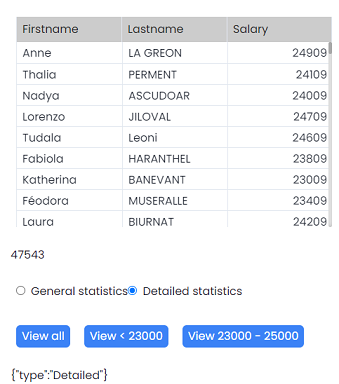Events
Events serve as a mechanism for initiating specific actions, often employed to trigger particular behaviors. They collaborate with various actions to establish dynamic interactions within an application.
For instance, when a user interacts with a webpage by clicking a button, you have the flexibility to determine the response, whether it involves invoking a function or opening another webpage. Furthermore, events can be activated in response to updates in a datasource.
Within Qodly Studio, events play a pivotal role in executing code on the Qodly web server, without requiring any supplementary JavaScript.
Types of Events
Events can be set to trigger either when end-users perform specific actions or when datasources are updated.
User events
You can configure events to activate in response to specific actions performed by end-users, such as clicking buttons, moving the mouse cursor, and more.
Typical user events include On Click, On DblClick, On MouseEnter, On Keyup, and others. The available events may vary depending on the selected component, and detailed documentation can be found in the Triggers and Events section on each component's page.
Datasource events
Besides events triggered by end-user actions, events can also be automated to respond when datasources undergo changes. The primary event for datasources is the On Change event.
When the On Change event is linked to a datasource, it will trigger in the following scenarios:
| Trigger | Description |
|---|---|
| Datasource | |
| Entity datasource | The contents of the entity attribute change |
| Entity selection datasource | |
| Scalar datasource | The contents of the scalar datasource change |
Managing events
The Contextual panel facilitates the association of class functions, navigation actions, and standard actions with distinct events within your application.
Adding an Event
To bind class functions, navigation actions or standard actions with events, follow these steps:
Select a Component or Datasource: Begin by choosing the component or datasource to which you want to attach an event. This selection can be made using the canvas, the outline, or, in the case of datasources, either the shared datasources area or the local datasources area.
Expand the Contextual Panel: Once your selection is made, expand the
Contextual panel . It will provide you with a list of compatible events specifically tailored to your chosen component or datasource.
. It will provide you with a list of compatible events specifically tailored to your chosen component or datasource.
Bind the Desired Action to the Event: Next, select the type of action
you wish to bind to the event. You have three options:
- Standard Action: Configure automatic actions on datasources, such as create, save, drop, or order by, without the need for coding.
- Navigation Action: Set up actions related to navigation within the application, such as opening another page or redirecting to an external URL.
- Class Function: Use a custom function to handle the event.
- Dialog Action:
Action Bound to Event: In the list of available events, you will notice a purple bullet
displayed on the left side of events that have already been configured (if any).
- Configure Event Properties: Complete the remaining steps specific to each action type, as detailed in the respective sections within the Configuring Events section.
You can define different actions for the same event.
Removing an Event
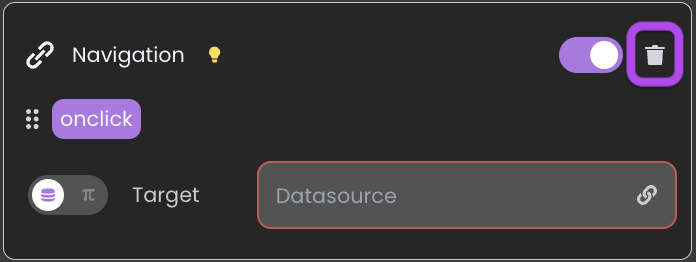
Toggling Event Execution
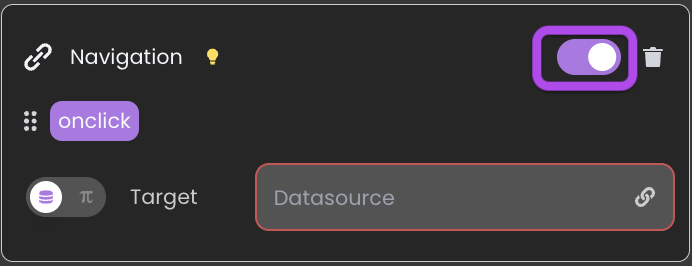
This feature is valuable for scenarios like debugging or temporarily pausing specific event executions without removing them from your application entirely.
Toggle Event Card Visibility
When the contextual panel is opened for a component or a datasource, all events are initially collapsed to provide a concise representation of their content. To expand all event cards, click the button at the top right of the contextual panel, and to collapse them, click on the
button.

Standard Action
For events bound to Standard actions, the collapsed card displays the datasource name involved, followed by its namespace if it's shared or Webform when local, on the left side. On the right side, the icon of the standard action is shown.

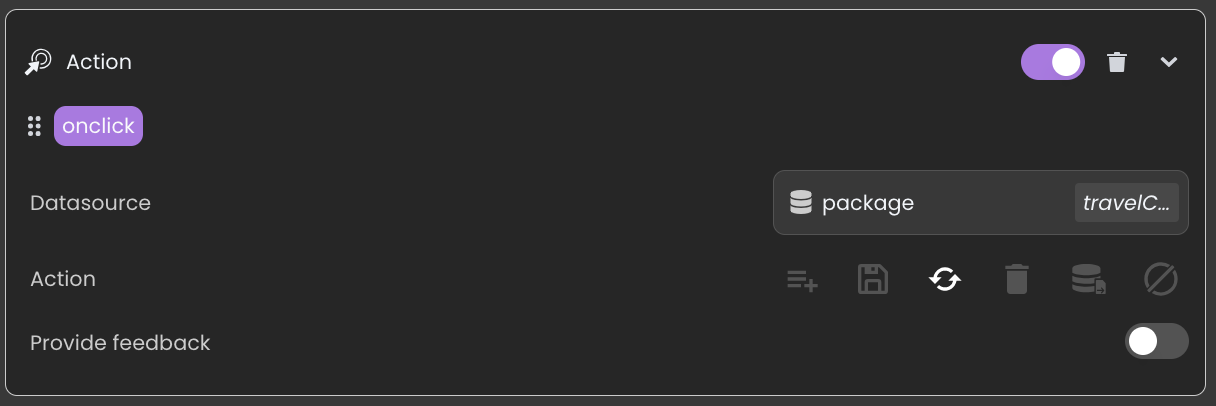
However, in specific cases, there may be minor differences in the display. For instance, in the case of the standard Copy action, the right side, instead of showing the icon of the standard action, displays the targeted datasource where the copying is intended.

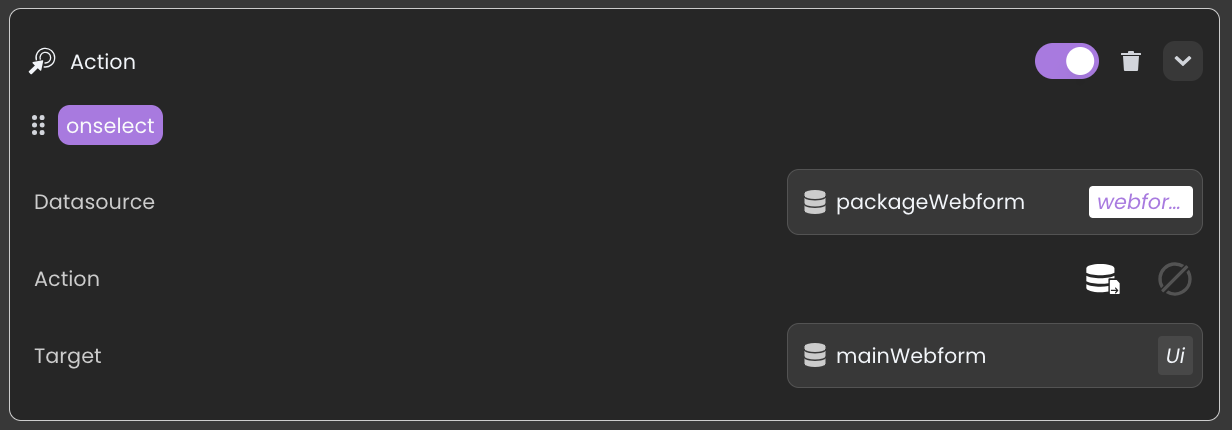
Navigation Action
For events bound to Navigation actions, the collapsed card displays only the targeted webform on the left side, with the icon of the transition method on the right side.

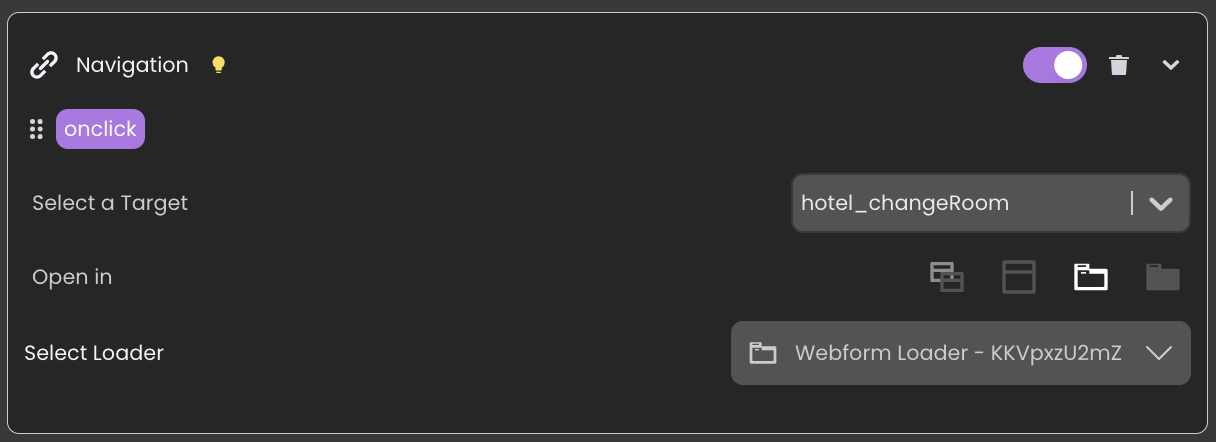
Class Functions
For events bound to Class functions, the collapsed card displays the function signature, including its name, parameters with filled values, and the returned result. The keyword displayed in the event card varies depending on the type:
- Exposed datastore class functions distinguishable by the keyword
Datastore.

- Exposed dataclass class functions distinguishable by the keyword
Dataclass Name.

- Exposed entity class functions and entity selection class functions, distinguished by the
Namespace Of Datasourcekeyword, encompass shared functions when these entities serve as shared datasources.

Reload Event Function Prototype

Chaining actions
In event coordination, actions are linked together sequentially. Pay attention to the alignment of each action with its predecessor, contributing to the overall flow and effectiveness of the process.
Preview Section
In the preview section, various capabilities are available when actions are bound to a specific event, depending on the type of action. It's worth mentioning that standard actions have no effect in this context.
- Preview Function Code: Selecting a function bound to a particular event allows you to preview its content within the preview section.

- Edit Function Code: To directly open and edit a function associated with a specific event, simply select the function and click on the function edit icon
.

- Open Linked Webform: When dealing with a navigation action bound to a specific event, selecting it allows you to access and open the webform associated with that event, using the same icon
.

Binding Standard Actions to Events
Standard actions apply to datasources, and their availability depends on the type of datasource. Datasources can be categorized into three types: Entity, Entity Selection, and Scalar.
Datasources
After binding a standard action with an event, follow these steps:
Define Action: Proceed to the Action section to unvail the available actions, which vary depending on the type of the datasource:
Datasource Type Action Icon Description Scalar Copy Copy the content of the datasource to a target datasource Set Value Update the datasource with a new value, which can be a String, Number, Boolean, Date, Array, or Object (with JSON validity). Note that this will trigger any configured OnChange event for the datasource. Clear Erase the content within the datasource Reset Resets the datasource to its initial value Entity Selection Order By Specify one or more attributes to sort and select direction Query The query is provided as a string and supports the same syntax as an ORDA query, except for formula ( eval) and thesettingsobject. Placeholders can be used with datasources or data as-isReload Reload the entire entity selection from the server All Load all entities of the same dataclass Clear Remove any content and create a new, empty selection of the same dataclass Reset Resets the entity selection datasource to its initial value (All or none) Copy Copy the entity selection to a target entity selection datasource Entity Create Generate a new entity from the corresponding dataclass Save Save the entity on the server Reload Reload entity values from the server Drop Delete the entity on the server Copy Copy the entity to a target entity datasource Clear Put nullin the datasource. If the datasource is the selected element of a component (Matrix, Select box, Datatable), clearing the datasource also unselects the selected elementReset Resets the entity datasource to its initial value (First or none) First Navigate to the first entity within the entity selection Previous Move to the previous entity within the entity selection Next Advance to the next entity within the entity selection Last Navigate to the last entity within the entity selection Entity (Standalone) Create Generate a new entity from the corresponding dataclass Save Save the entity on the server Reload Reload entity values from the server Drop Delete the entity on the server Copy Copy the entity to a target entity datasource Clear Put nullin the datasource. If the datasource is the selected element of a component (Matrix, Select box, Datatable), clearing the datasource also unselects the selected elementReset Resets the datasource to its initial value
Entities originating from an entity selection datasource enable iterative navigation within the selection, while Independently Created Standalone Entities are generated independently and lack any selection affiliation.
Provide Feedback: Enable the
Provide Feedbackcheckbox to customize the handling of unexpected error messages, determining what will be displayed to end users. For more detailed information, refer to the Provide Feedback section. Here, you have the ability to:- Provide simple UI feedback on a
Save,Reload, orDropstandard action on an entity. - Provide simple UI feedback on a
Reload,Order by, orQuerystandard action on an EntitySelection.
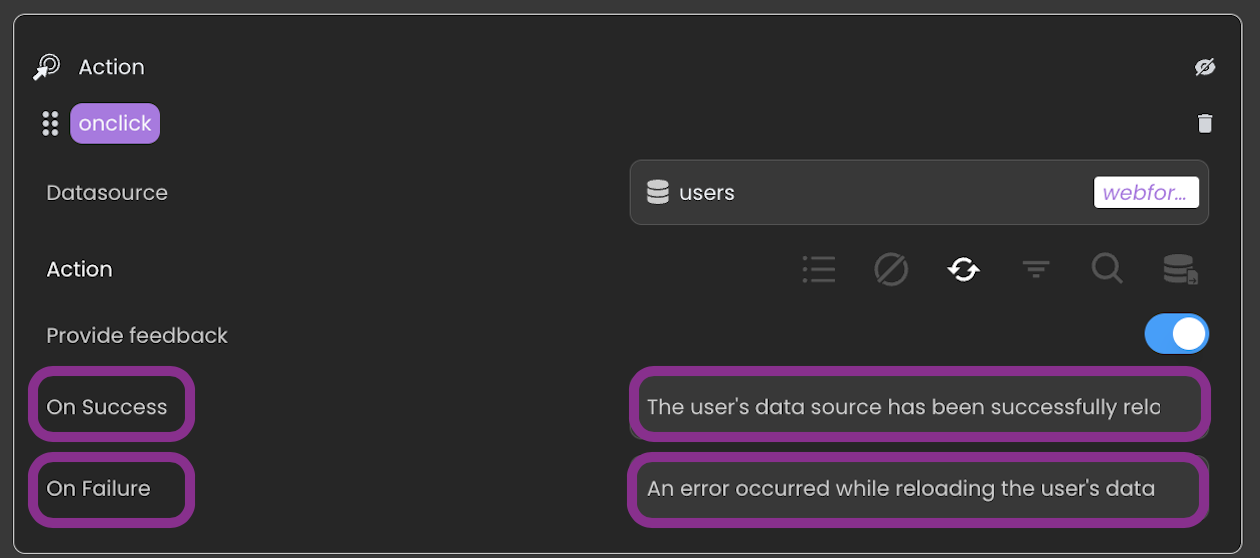
- Provide simple UI feedback on a
Binding Navigation Actions to Events

The navigation target can be defined in two ways using the toggle :
Datasources: When the destination Webform or external link is generated through server-side business logic. In such cases, provide a datasource of type string.

Hardcoded values: When selecting a Webform from the webforms list or providing a direct link as a hardcoded value.

Webforms
To set up a navigation action after linking it with an event, proceed as follows:
- Choose Target Type: Select the "Webform" option.

Either:
Specify Target Webforms for "Datasource" type targets: Enter the string-type datasource containing the name of the intended webform.
Explore Target Webforms for "Hardcoded Value" type targets: Browse through the list of available webforms, each serving as a potential navigation destination.
Define Transition Method: Define the approach through which the target webform will be presented based on the following options:
-
New Tab: Induce the opening of a new browser tab. -
Current Tab: Replace the ongoing browser tab with the chosen webform. -
Webform Loader: Access the intended webform through a dedicated Webform loader. -
Webform Loader (Self): Reveals content within the existing Webform loader .
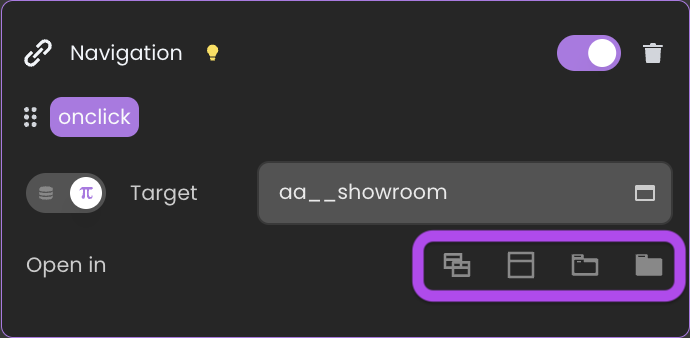
-
The feature for providing feedback is not applicable in the context of navigation events.
External Links
In addition to navigating to webforms, Qodly Studio offers a convenient way to direct users to external links. The process follows the same steps as outlined for associating navigation actions with events for webforms, with a slight variation in the "Target Type" step:
- Choose Target Type: Select the "External Link" option and input the URL of the desired external link.

- Define Transition Method: Similar to configuring webform navigation, you can specify how the external link will open. However, for external links, you have two options:
- New Tab: Induce the opening of a new browser tab.
- Current Tab: Replace the ongoing browser tab with the chosen external link.

Shared Folder
Accessing content stored in the Shared folder follows a process similar to navigating to external links. You have the option to display items from this folder, like images, in either a new tab or the current tab by specifying the image path (e.g., /$shared/visuals/banner.png) in the target field. Ensure that the path begins with /$shared.
When the path points to a file, it doesn't open it in a new tab but instead initiates a download.
Binding Class Functions to Events
Class Functions

Select a Function: Browse the available functions and select an appropriate class function. You can link events to various types of class functions, including datastore class functions, dataclass class functions, entity class functions, and entity selection class functions.
Pass Parameters: After selecting a class function, Qodly Studio automatically parses it, extracting its declared prototype. This allows you to visualize and configure its parameter(s) and return value. You can enhance the functionality of class functions by configuring parameters in two ways using the toggle
to define how the function parameter(s) should be filled, including the option to have variadic parameters.
- Select a Datasource for the returned result: In the return parameter section, choose a datasource to store the function's returned result.
- If your class function defines a specific variable for the result, its name will be displayed in the label within the return parameter section.
- However, if your class function does not specify a result name, the default label
resultwill be used in the return parameter section.


- Add Parameter: If your function accepts a variable number of parameters, you can use this button to declare and bind one or more appropriate parameter(s). They will be passed to the function in the defined order when called for the event.
- Provide Feedback: Enable the
Provide Feedbackcheckbox to display backend feedback on the user interface. For more detailed information, refer to the Provide Feedback section.
A single class function can be utilized across multiple events, allowing you to assign multiple events to a single function and observe a coordinated sequence of actions taking place.
Function Parameters & Variability
Parameter Handling
There are two primary methods for ensuring precise parameter handling:
Hardcoded values: Provide various types of values directly to the class function as parameters by selecting the type through the value icon
. Whether it's a string, number, boolean, or any other supported data type, simply choose the desired type from the dropdown list ensuring compatibility with the expected parameter type for precise and accurate results.
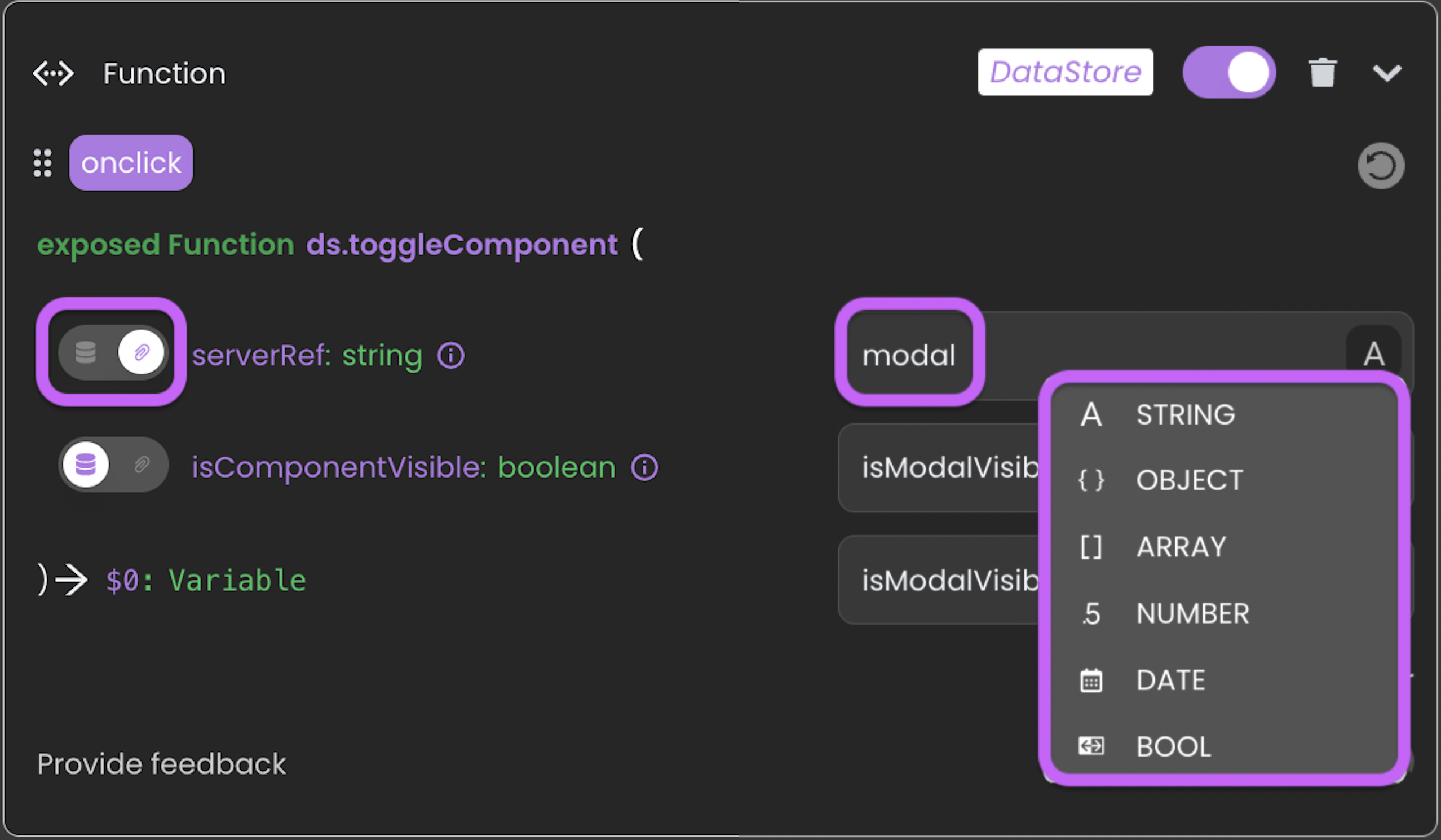
- The following types are supported as hard-coded values:
| Type | Description | Example |
|---|---|---|
| String | Any string value | Hello World |
| Object | JSON syntax | {"age": 12, "name": "Smith"} |
| Array | Collection of values | [10, 20, 30] |
| Number | Any numeric value | 42 |
| Date | A short-format date | 20/12/2024 |
| Boolean | True or False | False |

Datasources: Pass local or shared datasources as parameters to the class function. The scope of the datasource is indicated by a name tag. If the tag reads
webform, it signifies a local datasource visible only within the current webform. On the other hand, if there is a tag with a specific nameshared, it implies that you have passed a shared datasource belonging to a namespace.
Make sure the datasource value is of the same type as expected for the parameter by the function, otherwise an error will be returned.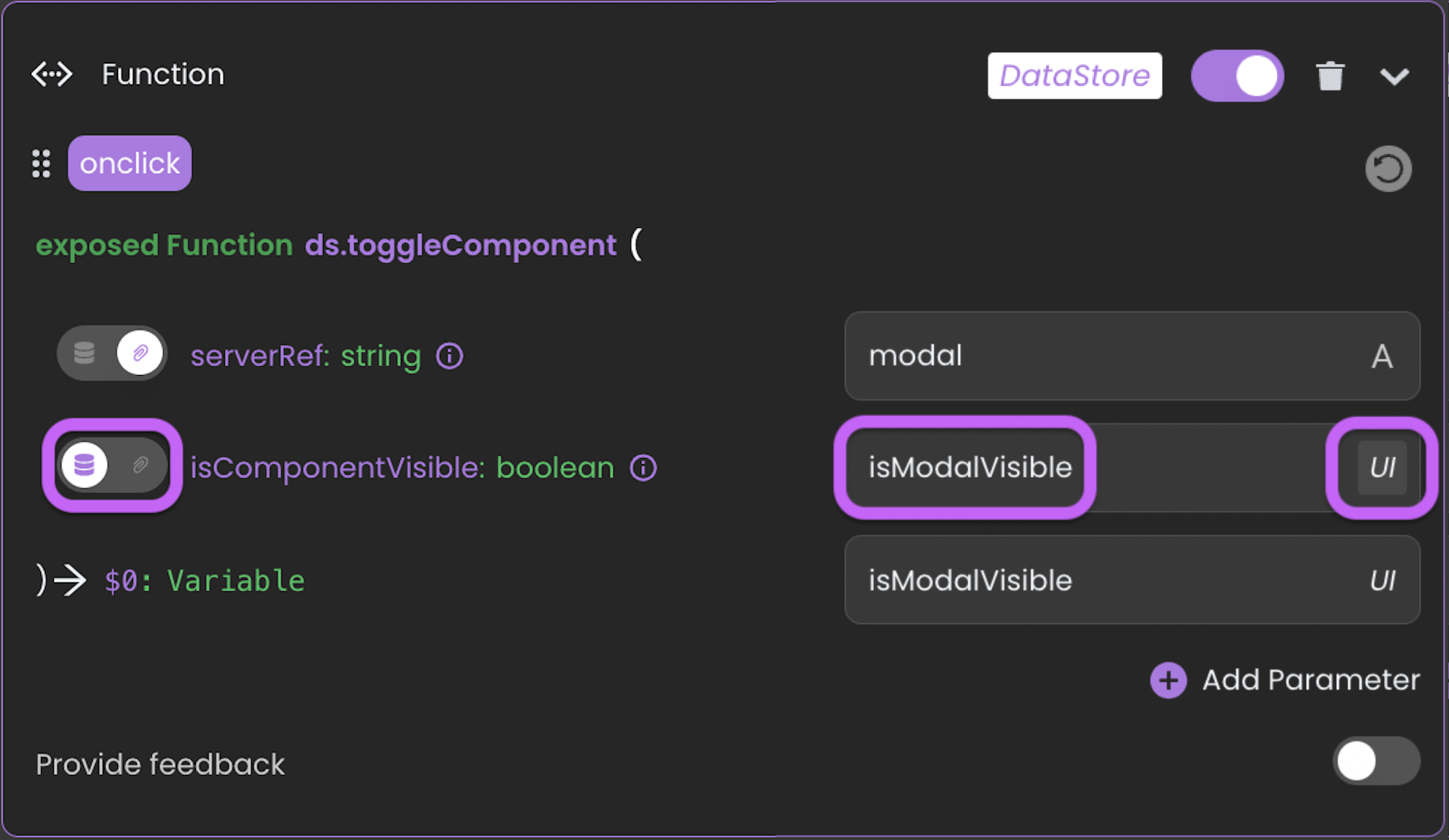
Variadic Parameters
... notation in function prototypes to handle a variable number of parameters.

Refreshing the Event Function Prototype after changing one of the parameter types resets them to match the updated information.
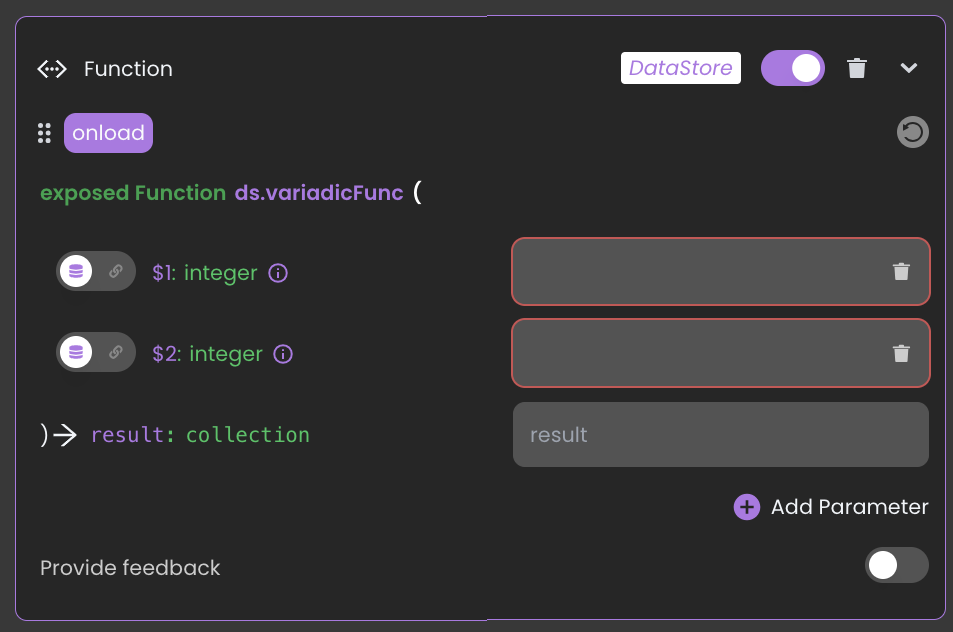


Binding Dialog Actions to Events
Add a dialog action in a component's event configuration, you can define the following:
- The type of action:
- Open: This action causes the dialog to be displayed.
- Close: This action leads to the closing of the dialog.

- The name of the dialog to be affected by this interaction.
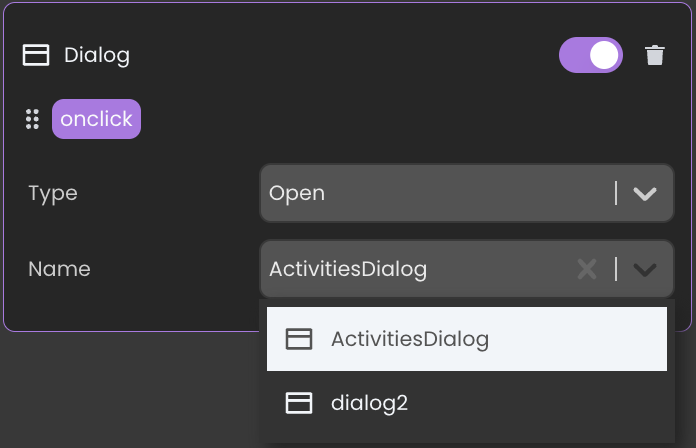
For further details, refer to the Dialog section.
Providing feedback
To provide feedback within the user interface, enable the Provide Feedback checkbox. This feature allows the backend to communicate with the user by displaying relevant messages regarding the outcomes of different functions or standard actions.
Importantly, this customized feedback aligns with the application's business rules and does not disrupt the application's navigation flow.
Toast Notifications
When the Provide Feedback checkbox is enabled, it introduces a hidden internal feedback element into the web page, known as a toast notification. This element automatically showcases messages generated by the application code in response to events, using dedicated webForm functions or by specifying them for On Success or On Failure in the WebForm editor interface, for the case of standard actions.
If this feature is not enabled, feedback sent from the backend will not be displayed within the user interface.
Control of Feedback Display
The Provide Feedback checkbox offers manual control over the display of feedback messages when executing a specific function. This manual control is designed to determine when to provide and display feedback, ensuring that messages precisely align with the specific needs of the user and the context.
For example, in the context of a technical document, regular users may require feedback messages to stay informed about the status of their requests, such as waiting for admin approval. However, administrators using a different interface to make modifications to the same technical document, which invokes the same function, might not need to receive the same message due to their administrative roles.
Three Tiers of Feedback
Three tiers of feedback are accessible and will be displayed as colored toasts:
Informative Messages: Dispatches informative messages when invoked, either directly through the
setMessage()function or by specifying them in theOn Successfield within the event section associated with a standard action.Cautionary Messages: Sends out cautionary messages, and these messages are exclusively triggered using the
setWarning()function.Error Messages: Issues error messages when invoked, either directly through the
setError()function or by specifying them in theOn Failurefield within the event section associated with a standard action.
Displaying multiple toasts through a single function is not supported.
Upon calling a function, it initiates an HTTP request, updating the UI simultaneously with the latest changes. This aligns with the principle that one HTTP request results in one response, leading to a single UI update.
Consequently, only the final update from the function will be visible in the UI, showcasing only the last toast.
The time these toast notifications remain visible is typically managed by Qodly Studio's internal logic.
They will automatically disappear after a preset 5-second period. Users can also manually dismiss them by clicking on the x icon.
Example of datasource events
In this scenario:
employees catalog datasource). • The "General statistics/Detailed statistics" Radio component is linked to the
choice webform datasource.• Buttons are bound to standard actions that perform queries on the
employee datasource (e.g., "salary < 23000").• An
on Change event is assigned to both the employees and choice datasources. These events call the same function from the EmployeeSelection class, named statistics.• For simplicity, the
statistics scalar datasource (object) is visualized as a Text component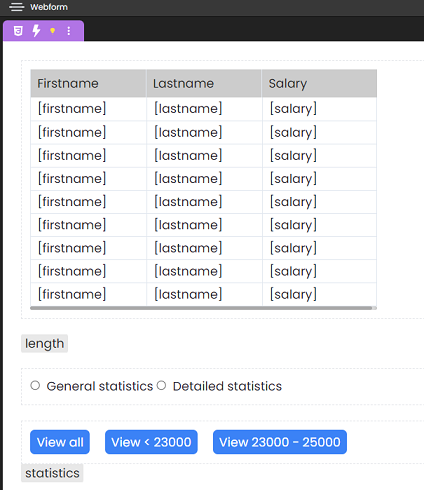
When a button is clicked or a radio button is selected, the employees datasource updates, prompting the on Change event. This function receives the value of the choice datasource as a parameter and produces general or detailed statistics as an object based on the parameter value.

Here's what you obtain after the button is clicked:
